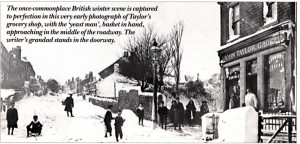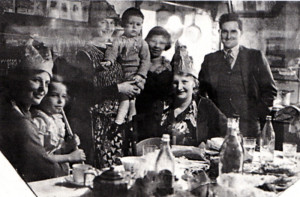 I could hardly believe it when I read recently that a biscuit tin, in the shape of a bus and made by Crawford’s, with the name lithographed on the sides and originally costing 2/4d when filled with ‘Nursery Assorted’ in 1929, had been sold at auction for £2,750.
I could hardly believe it when I read recently that a biscuit tin, in the shape of a bus and made by Crawford’s, with the name lithographed on the sides and originally costing 2/4d when filled with ‘Nursery Assorted’ in 1929, had been sold at auction for £2,750.
When I lived with my grandparents and parents at a village shop in Yorkshire, lots of those and other biscuit tin novelties were ‘put on one side’ by customers in the weeks leading up to Christmas until they had saved up, and also so that their presents wouldn’t be seen until the proper time. My brother Philip and I were in the enviable position of being able to see all these wonderful Christmas goods first.
There were no ‘sell by’ dates in those days. Customers were too eager to devour the contents, and children were impatient to play with the tin bus, fire engine or whatever the ‘toy’ was. Huntley & Palmer’s made a tin in the shape of a grandfather clock which, filled with ‘Wine Mixed’ sold at 2/-, and a ‘handbag’ filled with Marie biscuits for 1 /3d. They also produced an ‘Italian Casket’ filled with Afternoon Tea biscuits, ‘up-market’ at 5/-.
A tin of shortbread was always an acceptable gift for maiden aunts who might have scorned perfume. McVitie & Price’s Yuletide shortbread tin, depicting a Victorian group with lanterns on the lid, cost 2/4d. Crawford’s tea caddies were popular, filled with Festive Mixed at 2/3d.
Country salerooms, jumble sales and car boot sales are worth visiting in a search for these biscuit tins shaped like vehicles or other novelties. Or how about turning out the attic or asking older relatives if they have any old biscuit tins in cases and boxrooms?
Stick-on labels were common at first, then Huntley & Palmer started printing directly on to biscuit tins in 1867.
If only we could have seen into the future when our shop was sold in 1948. How valuable some of those old tins would have become!
I still have an Ogden’s Redbreast Flake tin, with a picture of a robin on a twig, and the warning: “This brand of tobacco is the exclusive property of The Imperial Tobacco Co. (of Great Britain and Ireland).” And: “This tin is not to be filled with other tobaccos.” I also have a tin that originally housed Blue Bird Toffee, with the words:
“Take the Home Sweet Home” on both sides. Produced by Harry Vincent Ltd. of Hunnington, Worcestershire, it has a picture of roses on the lid.
My mother kept a Victory ‘V’ tin as a tea caddy. Inside the lid is printed: “The world’s winter sweetmeats. Victory ‘V’ for cold journeys. Gums and lozenges. Sold all over the world.
Nothing just like ‘Victory’. Manufactured only at Victory Factories, Nelson, Lancs. Makers of all kinds of confectionery. Ask for lists.” The tin is decorated with Chinese figures.

Another souvenir of our shop is a Mackintosh’s toffee hammer.
Grandma used to hammer squares of toffee into smaller pieces, then pop them into cone-shaped paper bags.
Commercial travellers never failed to bring Christmas gifts for us. The Lyons Tea traveller gave me a bumper thick Schoolgirl’s Own Annual in 1937, when I was ten. The hobson ‘s Tobacco traveller presented mother with boxes of ‘Passing Clouds’ cigarettes, the tips delicately tinted in the palest pink and mauve. On the shelves on the approach to Christmas were packets of cigars, and a few special thick ones with a picturesque band round the middle.
Mow I adored the sets of Atkinson’s Californian Poppy boxes with three tablets of soap for 2/9d, or their Eau de Cologne at 2/-, Verbena (boxes of three) for 3/9d, Lilac and Lilies (three tablets) fore 2196 and one called, romantically, Au Revoir. We always stocked Pears’ Golden Glory (three tablets for 2/-) and the delightfully-named Otto Roses.
A few Joy Bombs were also ordered from the wholesaler. These were always bought by the more affluent customers, and we always kept a couple back for home use. One of these was in the form of a big snowman, covered in cotton wool and topped with a black cardboard top
hat, which burst open to scatter small novelties around the festive table.
There were special seasonal attractions such as jars of ginger in syrup, a 11b jar costing 1/71£d, glace and crystallized ginger, oval boxes of Tunis dates with a dainty cardboard fork inside, and round cardboard boxes of ‘orange and lemon slices’ adorned the shelves in December.
Dad hung a few huge Chinese lanterns from the shop ceiling, and these swayed among the dangling rolls of bacon and ham when the shop door tinkled.
For customers’ children, a few board games were for sale. There were tiddleywinks, blow football, Italian mosaics (triangular pieces of richly-coloured wood to be made into mosaic designs), and these generally cost 1/6d for a small box, 3/- for a large one. Then there were selection boxes and pretty round tins of toffee, and packs of green, red and yellow crepe paper from which customers could create their own Christmas tablecloths and trimmings.
There was no need for us to go out into the wintry weather and do our Christmas shopping. It all came to us, not to mention the fun of our customers coming in and out all day long. Lucky ones were kissed beneath the sprig of mistletoe positioned strategically above the counter, should a merry commercial traveller be there!
I wouldn’t have swapped my childhood at the village shop for anything, especially at Christmas time!
Hazel Wheeler








